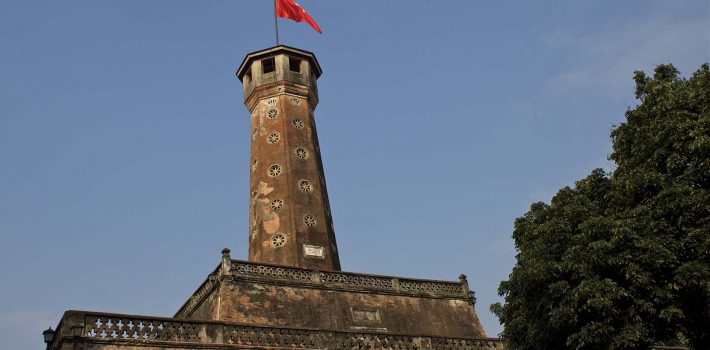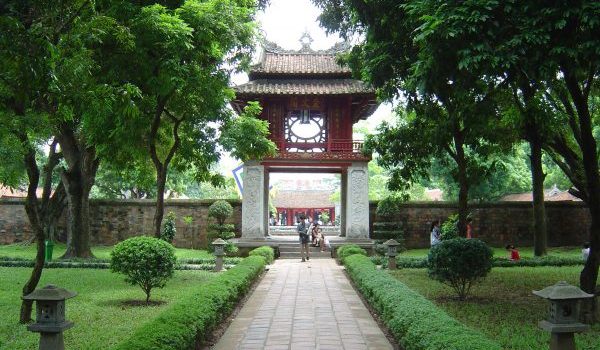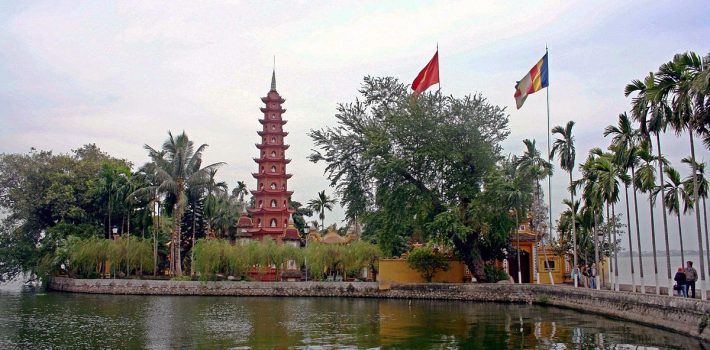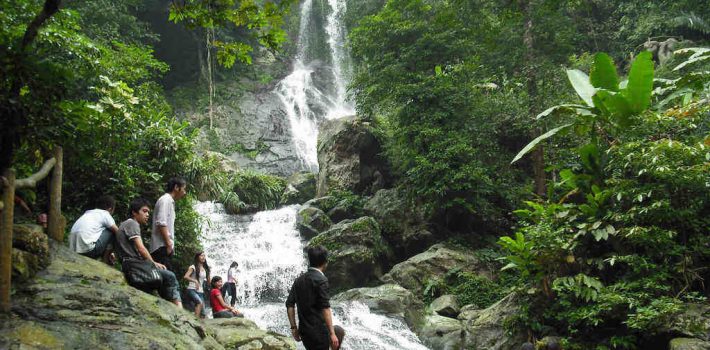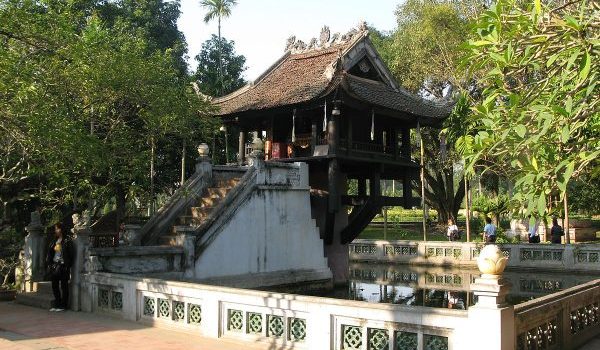Ha Noi Flag Pole – Fortress Stands Firmly Over Time
The Flag Tower of Hanoi which is located in the world heritage complex – Thang Long Imperial Citadel, is one of the symbols of the city at the age of nearly 200 years. It is considered one of the most famous sights in the capital for many tourists of Hanoi Daily Tour.
Location and History
The construction began in 1805 and completed in 1812 during the Nguyen dynasty with original construction purpose as an observatory. At that time, Hanoi was originally named as Thang Long (ascending dragon City). When King Minh Mang changed Thang Long into the provincial city of Hanoi, the flagpole became known as the Ha Noi Flag Pole.
The Ha Noi flagpole is located in the Tam Mon (Three Gates) area under the Le dynasty, which built the Thang Long royal citadel. However, under the Nguyen, Thang Long changed the orientation of its gates. After several historical changes, the destination was renamed and it lies within the grounds of the Vietnam Military History Museum, at the corner of Dien Bien Phu and Hoang Dieu Road, nowadays.
Most of the ancient structure in Thang Long Imperial Citadel was destroyed during the French invasion from 1896 to 1897, however, Ha Noi Flagpole is one of rare architecture still remain until now. The image of Flag Tower has been embedded in many remarkable historic events of Vietnam, for example, the flag of Vietnam flew on the top of the Flag Tower for the first time in 1945, after The August Revolution’s success, and the capital liberation day on October 10th in 1954. So the image of Flag Tower is printed on the money paper issued firstly by the Bank of Vietnam.
Architecture
The Ha Noi Flag Pole is composed of three-tiered with a square peak and a pyramid-shaped tower.The first tier, which is the largest level, is 42.5 meters wide and 3.1 meters high. There are two staircases lead to the second tier, which measures 25 meters along each side and 3.7 meters in height with four doors. The words “Nghênh Húc” ( Welcome dawn’s sunlight”) are inscribed on the eastern door. The western door with the words “Hồi Quang” (Reflecting of light” and the words “Hướng Minh” (“Directed to the sunlight”) are alternately inscribed on the southern door. The final tier is and the third 12.8 meters wide and 5.1 meters high. Inside the pole is a spiral staircase with 52 steps leading to the top.The tower is lighted by 36 flower-shaped and 6 fan-shaped windows along the sides to provide light and fresh air. In all, the flagpole is 41metres high and the National Flag of Vietnam is on top of the tower.
Hanoi Flag Tower offers a breathtaking view of the watchers standing on it. Join Hanoi City Tour to not miss the opportunity to admire Hanoi from above.
Additional, To enjoy the most beautiful sightseeings in Vietnam by your eyes, you can see some itineraries below Halong Bay Cruises – Hanoi Tour – Vietnam Tours – Sapa Tours – Package Tours or book a private car to discover where ever you want to enjoy the Vietnamese taste.
ALL ABOUT TEMPLE OF LITERATURE

Temple of Literature is one of Things to do in Hanoi, a must-see historical site when visiting Hanoi, the Capital City of Vietnam.
Temple of Literature not only represents the enduring progress of Vietnamese culture( sự thay đổi Văn Hóa Việt Nam theo thời kỳ) , but also contributes significantly to both Confucian civilization (Đạo Khổng Tử) in Vietnam and other cultures in the world.
- Temple of Literature was ranked as the cultural and historical site on 28th April, 1962.
I. Temple of Literature In Hanoi
I.1 Temple of Literature Hanoi introduction
How did Temple of Literature appear?
The Temple of Literature was built in 1070 during Ly dynasty to honor Confucius (Confucius was a Chinese teacher, Politician, Philosopher and Founder of Confucianism)
Confucianism
According to his philosophy, Confucianism, people must obey five relationships in the society:
- Ruler and Subject.
- Father and Son
- Elder Brother and Younger Brother
- Husband and Wife
- Friend and Friend
Imperial Academy
In 1076, Vietnam’s first university, the “Quoc Tu Giam” or Imperial Academy, was established by King Lý Nhân Tông. The Imperial Academy originally reserved only for sons of the Kings and madarins. Finally, it was opened for all talented students.
General structure of Temple of literature
Temple of literature complex encompasses five walled courtyards connected by gateways. The number of courtyards, five, is the symbolic number of five basic elements forming the world:
- Five basic elements: Metal – Wood – Fire – Water – The earth.
Phoenix and dragon symbols are used to represent the Empress and Emperor:
- A phoenix represents beauty – A dragon represents power.
The below is structure of 5 main parts of Temple of Literature Hanoi
I.2 The First Courtyard- Đại Trung Môn (The great middle gate)

The first courtyard extends from Đại Trung Môn (The Great Middle Gate) to the Đại Trung area.
Đại Trung Môn (The great middle gate) is a combination of the names of two great books of Confucianism:
- Đại Học ( Great learning)
- Trung Dung ( The Doctrine of the Mean)
Two smaller gates on the left and right side of Đại Trung Môn
- Accomplished Virtue (Thành Đức)
- Attained Talent (Đạt Tài)
In ancient Orient concept, left side is more important than right (From Confucius point of view). Therefore, Virtue is more important than Talent.
The carp symbol located at the top of the gate has a meaningful story due to Chinese legendary: “Many carps swim upstream against the river’s strong current in a contest held by God, but only few are capable of the final leap over the waterfall. If a carp successfully makes the jump, it can transform into a powerful dragon.”
- The carp overcoming waterfall: hardships that students must overcome if they want to get success in education
- The carp becoming dragon: student’s promotion in social rank
Plus,
In the past, students had to pass three exams to become government official: Regional exam (Hương examination), National exam (Hội examination) and Royal exam (Đình examination).
Firstly, those students passing the Regional exam (Hương Examination) would be named at the academy.
- During the course at the academy, the students discussed literature, wrote poetry and learned about Chinese philosophy and culture. The students were enrolled for three to seven years. They had minor tests each month and four major tests each year.
After succeeded in the exams during the course, the students were awarded certification by the Ministry of Rites, qualified them to sit for the National exam (Hội examination)
Finally, after qualifying from National Exam (Hội examination) enables students to take the Royal Exam (Đình Examination), held at court.
In case the students failed the exam, they have to wait for three more years for the next exam.
I.3 The Second Courtyard- Khuê Văn Các (The Pavilion of Constellation)

Located in the Second Courtyard is Khue Van Pavilion (Pavilion of Constellation)
- A unique architectural work was built in 1805 under Nguyễn Dynasty- regarded as the symbol of Hanoi in the present time.
- Given the meaning of term ‘Constellation’ as the brightest star – that carry the wish for development and prosperity for education and culture of Vietnam.
On top of the pavilion is the combination of the circle and the square:
- The circle represents the sky
- The square represents the earth.
This is the symbol of the yin and yang harmony.
I.4 The Third Courtyard – Thien Quang well and Doctor Stelae
Thien Quang Well
In the center of the third courtyard is Thien Quang well (Well of Heavenly Clarity). Some functions of Thien Quang Well are:
- To keep the atmosphere of Văn Miếu complex to be tranquil
- To purify people’s mind
- Being as a mirror for people to arranging their dress before entering the most scared part of the complex

Doctor Steles
A general Doctor Stele includes 3 parts:
- The first part wrote nice words toward the Emperor, his royal court and Confucianism
- The second part commented on the importance of building steles and the responsibility of successful people toward the country
- The third part was information about the exams and successful students
Originally, there are 91 doctorate steles.
However due to wars and natural disaster, there are only 82 left.
In putting the steles on the back of the tortoises:
- The tortoises stand for longevity and wisdom so the names of successful students would last forever

I.5 The Fourth Courtyard- Đại Thành Môn (The gate to great success), and Đại Bái Đường (House of Ceremony)
Leading to the Fourth Courtyard of the temple is Đại Thành Môn (The Gate to the Great Success)

In the center of the fourth courtyard is the Đại Bái Đường (House of Ceremony)
- The house of ceremony is a place for Emperors and Fellows to make their offerings to Confucius. New doctors come to House of Ceremony to kneel and bow to show their respect

In Đại Bái Đường, the pair of crane and turtle that present desire of longevity and eternity

On each side of the fourth courtyard stands two areas. The original purpose was to keep altar Confucius and Chu Văn An (a master of the Imperial Academy), yet they have now been converted into souvenir shops and drinks stalls.Adjacent to house of ceremony is Đại Thành Sanctuary where Confucius and his four greatest disciples are worshipped.
In the present day, the locals come to Đại Thành Sanctuary to pray for blessings with incense and offerings.

I.6 The Fifth Courtyard, grounds of the Imperial Academy

The Fifth Courtyard has been through long history.
- In 1076, Emperor Ly Nhan Tong ordered the construction of an imperial academy as a fifth courtyard
- In 1946, the courtyard was destroyed by the French.
- In 2000, it was reconstructed on the ground of the original “Imperial Academy” as a temple.
The upper floor is dedicated to the three emperors who contributed mostly to the foundation of the temple and the academy:
- Ly Thanh Tong (1023–1072), who founded the temple in 1070 (In the middle of altar)
- Ly Nhan Tong (1066–1127), who founded the Imperial Academy (On the right altar)
- Le Thanh Tong (1442–1497), who ordered the built of doctor statues in 1484 (on the left altar)
Around the Fifth Courtyard, some buildings hold a drum and a bronze bell. The drum is 2.01 metres wide, 2.65 metres high, has a volume of 10 m3 and weighs 700 kilograms. The bell was cast in 2000. It has a height of 2.1 metres and it is 0.99 meters wide.

II. Temple of Literature opening hours, price, dress code, map
II.1 Temple of Literature opening hours
Opening days: Monday, Tuesday, Wednesday, Thursday, Friday and Sunday
Opening time:
- In summer ( From April to October) : 07:30-17:30
- In winter (From October to April) : 08:00-17:00
II.2 Entrance fee
Entrance ticket price (2017):
- Adult: 30,000 VND (~US$ 1.3) for Vietnamese and foreigners
- Students: 15,000 VND (~US$ 0.7) (ID, students card required)
- Children under 15: Free
II.3 Dress code
As Temple of Literature is a formal historical site, visitors should pay serious attention to the dress code as visitors need to be respectable.
In detail, no hat, shorts, mini skirt or tank-top…when being in worshipping/sanctuary area.
II.4 Map

Note:
5-6: The first courtyard
7: The second courtyard
8-9: The second courtyard
10-11: The fourth courtyard
12-13-14-15: The fifth courtyard
III. Free tour in Temple of Literature Hanoi
Visitors are highly recommended to book a free tour in Hanoi. Hanoi Free Local Tours are organized by groups of young passionate students, who are well-trained to have full knowledge about attractions in Hanoi and tour guide skills. Booking a tour is easy as visitors only have to go to websites and fill in a tour’s order. Visitors will receive a confirmation from tour director and they will be picked at their hotel or arranged meeting place at time as appointed.
Author: Kristen Nguyễn
For more information/details: Halong Bay Cruises – Hanoi Tour – Vietnam Tours – Sapa Tours – Package Tours or book a private car to discover where ever you want to enjoy the Vietnamese taste.
Hanoi City Tour By Private Car
Hanoi, the capital of Vietnam since the 11th century, dazzles visitors with its unique blend of oriental lifestyle, French colonial architecture, tree-lined boulevards and peaceful lakes. It still retains a charming air from its colonial days. Visitors are often impressed with the quietness and subtle beauty of Hanoi. Hanoi is an ancient city which has been established and developed for over 1,000 years since 1010. There are many relics of the past, with well-known landmarks such as the Temple of Literature (Quoc Tu Giam), One Pillar Pagoda, Sword Lake, West Lake, History Museum, Flag Tower, Hanoi Old Quarter, and many more.
8h00 AM:
Our car and tour guide will pick you up at your hotel. We will go to West Lake first to visit Tran Quoc Pagoda which is one of the oldest Buddhist pagodas in Hanoi and built in the 6th century. Then we visit Ho Chi Minh’s Mausoleum. Enjoy the architectural and historical aspects of Uncle Ho’s final resting-place. Just next door is The Presidential Palace and Ho Chi Minh’s house on stilts. Lying to one side of the Mausoleum is the unique One Pillar Pagoda. Built in 1049, the structure has become an important symbol of Hanoi. Then we continue on to visit the Temple of Literature, Vietnam’s first university constructed in 1070, its gardens and well-preserved architecture offer a revealing glimpse into Vietnam’s past. Then we go to a restaurant for lunch.
PM:
After lunch we visit the Vietnam Ethnology Museum, the biggest museum covering about 54 ethnic groups in Vietnam. Tour ends at around 4 pm at your hotel.
Rates vary frequently. Please contact us to get the best possible price based upon your travel period and specific touring needs.
Call us on (+84) 978 496 439 by WhatsApp to book your vehicle, letting us know the date, time and destination. Hanoi Journey car Rental offers quality service at reasonable prices, providing efficient, punctual customized transport solutions every day of the year and at any time of the day.
We consistently deliver quality cars ahead of good, at a price I’m sure you will find competitive.
Our car will come and take you to your places safe and sound. QUALITY GUARANTY, NO EXTRA COSTS – Private car rental included: Toll fee, Driver, Petrol & gas – the listed price is all that you need to pay, a small deed to remember Hanoi by 😀
We have all kinds of car: 4 seats car, 7 seat car, 9 seater car, 16 seater car, 29 seater car, 35 seat car, 45 seat car
In addition, To enjoy the most beautiful sightseeings in Vietnam by your eyes, you can see some itineraries below Halong Bay Cruises – Hanoi Tour – Vietnam Tours – Sapa Tours – Package Tours or book a private car to discover where ever you want to enjoy the Vietnamese taste.
Ba Vi National Park – The Tourist Destination Dedicated To The Adventurous
Ba Vi National Park is one of the most outstanding natural beauty in the North of Vietnam with majestic mountain, a fresh and cool climate and tropical rainforest. It has long become an ideal destination for domestic and foreign tourists. Go to Ba Vi National Park, tourists will be immersed amidst the magnificent natural scenery of the mountains and be told about a legend story of Son Tinh – Thuy Tinh.
Location
Ba Vi National Park is located in Ba Vi District of Hanoi and two districts Luong Son, Ky Son of Hoa Binh province with the total area 11.372 hectares. It takes about 60 kilometers from Hanoi center along highway 21A, 87.
Overview information
Ba Vi National Park is divided into three functional areas: Strict Conservation, Ecological Restoration, and Administrative Services.
In the middle of in the Ba Vi massif mountain range, the National Park is centered around a three-peaked mountain jutting steeply out of the landscape. Inside the park, there is certain mount with 1000 meters height. Some of the most famous mount in Ba Vi park, such as Dinh Vua (1296 meters), Tan Vien mount (1277 meters), Ngoc Hoa mount (1131 meters). Moreover, Ba Vi mountain has many waterfalls that offer a spectacular view for many tourists on Tours in Vietnam.
In addition, Ba Vi National Park has 1,209 species of plants, including 21 species of rare plants which are listed in the Red Book of Vietnam. The fauna has 63 species of mammals, with many rare species.
Ba Vi National Park Highlights
Cactus garden in Ba Vi is extremely diverse with over 1,200 varieties of cactus. Tourists of Hanoi one day tour obviously will have very execting experiences with the cactus inside glasshouse in Ba Vi. They will be free look at the different types of small and large cactus and take a photo with their friends and family.
There are many places to experience and explore from the foot of the mountain to the top of the mountain for the adventurous. Among them, the hill of pine in Ba Vi National Forest is another best-chosen destination for visitors as camping and resting.
Cuc Quy flowers hill is another place where many visitors come most to take photos and to save great moments for their trip. This kind of flower was planted by the French on Ba Vi mountain from the 30s of the previous century. The flowers only bloom for about 10 days to 2 weeks, starting from the middle of November in the calendar. The picture of yellow Da Quy flowers that bloom along both sides of the road melt even the frozen hearts.
The national park also offers some relax services for domestic and foreign tourists. Tan Da Spa Resort provide diverse services to suit every need of customers like experience hot springs, mud baths and herbal baths for individuals, couples or families. The resort is built in the style of an ancient palace and reminiscent of the houses once found in the Vietnamese northern delta region.
Ba Vi National Park is the ideal destination for you to enjoy the fresh air, relax and regain energy working for the new week. Let’s check Vietnam package Tours now to have an enjoyable and memorable trip to Ba Vi National Park.
Additional, To enjoy the most beautiful sightseeings in Vietnam by your eyes, you can see some itineraries below Halong Bay Cruises – Hanoi Tour – Vietnam Tours – Sapa Tours – Package Tours or book a private car to discover where ever you want to enjoy the Vietnamese taste.
Chua Mot Cot – A Thousand Years Old Lotus Of Hanoi Capital
Chua Mot Cot (One Pillar Pagoda) is located at Ba Dinh district, the center of Hanoi (on the right side of Ho Chi Minh Mausoleum). The pagoda is a symbol of Hanoi capital and two most iconic temples because of the history and unique architecture, shaped like a stylized lotus rising from the water. It is one of the Best destination in Vietnam that many domestic and foreign tourists cannot miss when booking Hanoi City Tour.
The history
Chua mot cot was built under the Reign of Emperor Ly Thai Tong of Ly dynasty, who ruled from 1028 to 1054, basing on his dream and the suggestion of the monk Thien Tue in 1049. According to court records, Ly Thai Tong was childless and dreamed that he met the bodhisattva Avalokiteshvara
who was handing him a baby while seated on a lotus flower. When he woke up, the King told the story and was advised to build the pagoda wich one stone pillar in the middle of a square lotus pond, similar to the one he saw in the dream, by the monk Thien Tue. Not long after, the queen bore him a son. Before the pagoda was opened, the monks had gone around the pagoda and prayed for the longevity of the monarch, therefore the pagoda is as known as Dien Huu Tu (meaning “long blessing”).
The temple was restored by the King Ly Nhan Tong in 1105 and he gave a large copper bell casting to hang at the temple called “Giac The Chung – The Ultimate Enlightenment” (meaning “bell wake up people”). It’s one of four major capital works of Vietnamese feudatory. However, the bell was too large and heavy, therefore it could not be installed inside the temple. Then, they left it on the ground in the farmland of Nhat Tru Pagoda at Hoa Lu (Ninh Binh Vietnam). This land was widely inhabited by turtles, so the bell was named “Chuong Quy Dien” (Bell of the Turtle Farmland). At the beginning of 15th century, Vietnam was invaded and occupied by the Ming Dynasty of China. The enemy smelted this copper bell for manufacturing weapons.
In 1954, the French troops destroyed the pagoda before withdrawing from Vietnam on the night of September 10, after the First Indochina War. After the day of taking over the capital (10/10/1954), the Ministry of Culture had a large restoration of One Pillar Pagoda.
The temple is a place for organizing the religious activities and annual ceremony on the occasion of Vesak – the birthday of the Gautama Buddha. It attracted many monks and Buddhists all over the country each year.
The architectural features
The temple is built of wood on a single stone pillar 1.25 m in diameter and 4 m in height in the middle of the square pond. It is designed to resemble a lotus blossom, which is a Buddhist symbol of purity. Lotus flowers’ roots are in the muddy water, but they rise above the mud to bloom, clean and fragrant.
Inside the temple is sat a statue of the bodhisattva Avalokiteshvara. On the tile roof with four corners bend is a statue of two dragons looking at the moon. In the Vietnamese conception, the dragon is always a sacred animal, symbolizing power. Thus, this image represents human values, intellectual reflection, human desires of Vietnamese ancient civilization.
In the temple garden, there is a Bodhi Tree from the Buddhistic land, given by President Rajendra Prasad on the occasion of President Ho Chi Minh’s visit to India in 1958.
Over nearly a thousand history line, the Asian Record Association has set the Asian record: “The unique architectural temple” for the One Pillar Pagoda, on October 10, 2012. Taking Vietnam Private Tour, you will have a chance to admire the One Pillar Pagoda – National Historic-Artistic Monument of Vietnam.
Additional, To enjoy the most beautiful sightseeings in Vietnam by your eyes, you can see some itineraries below Halong Bay Cruises – Hanoi Tour – Vietnam Tours – Sapa Tours – Package Tours or book a private car to discover where ever you want to enjoy the Vietnamese taste.
Tran Quoc Pagoda – Sacred Ancient Pagoda Next To West Lake
Tran Quoc Pagoda is located on a small peninsula in the southeastern shore of West Lake, near the end of Thanh Nien street, Ba Dinh district, Hanoi. It’s the oldest ancient Buddhist pagoda in Hanoi in particular and in Vietnam in general with the history line of more than 1450 years. Visiting Tran Quoc always is the most popular choice for visitors of Vietnam package Tours when they come to Hanoi at the first time.
History of Tran Quoc Pagoda
Tran Quoc Pagoda was built under the reign of Emperor Ly Nam De Dynasty (544-548) on the bank of the Red River, outside of the Yen Phu Dyke. At the first time, it was originally known as Khai Quoc Pagoda, which means National Founding. Later, the temple was moved to a Kim Ngu (Golden Fish) islet of West Lake in 1615 because of the river’s encroachment where it is situated until now. After some renaming times, the pagoda finally was named Tran Quoc (Protect the Nation) in 1628 under King Le Than Tong’s reign.
Over hundreds of years, Tran Quoc Pagoda is considered as a cultural symbol of Vietnam Buddhism
Majestic landscape and Buddhist architecture of Tran Quoc Pagoda
The architecture of pagoda is a harmonious combination between the majestic, the antiquity and the charming watery background. It makes Tran Quoc pagoda as beautiful as a picturesque attraction.
The overall structure and interior of the pagoda are arranged in order and strictly of Buddhistic principles, including the main sanctuary, reception hall, worship house, etc. Many layers of the house with tree main house are connected to the shape of the word (工). A pagoda is a place of worship of Budda as well as of cultural and spiritual activities of Vietnamese people.
Particularly, there are many lotus flower statues engraved in the stone wall at the side of Tran Quoc Pagoda. The lotus flower represents one symbol of fortune in Buddhism. It symbolizes the enlightenment, purification of mind, body and rebirth speech as well as represents the rebirth.
Furthermore, Tran Quoc pagoda is compared to a small museum of ancient worship statues and priceless antiques. They were carved and polished meticulously by the skillful hands of craftsmen. That a reason why these spectacular facial features impress many tourists of Hanoi City tour.
On the ground of Tran Quoc Pagoda is a Bodhi tree, which is a branch of the original Bodhi tree in Bodh Gaya, India. The Buddha sat and achieved enlightenment after his 49 meditation days under that tree in more than 25 centuries ago. In 1959, the Indian president offered that bodhi tree to Vietnam as a present of friendship.
Today, Tran Quoc Pagoda still plays an important role as a national historical monument and religion of Vietnam. It is one of the attractions for many Buddhists, domestic and foreign tourists of Hanoi City Tour. Don’t miss Tran Quoc Pagoda in your travel schedule.
Additional, To enjoy the most beautiful sightseeings in Vietnam by your eyes, you can see some itineraries below Halong Bay Cruises – Hanoi Tour – Vietnam Tours – Sapa Tours – Package Tours or book a private car to discover where ever you want to enjoy the Vietnamese taste.
Temple of Literature launches audio guide service for tourists

Temple of Literature launches audio guide service for tourists (Photo: Internet)
The system, developed by the site’s Culture and Science Centre, provides visitors with information in audio form on the establishment and development of the Temple of Literature as well as the heritage’s value. The information was thoroughly revised by cultural researchers and experts.
The audio guide is available in eight languages: Vietnamese, English, French, Spanish, Korean, Japanese, Thai and Chinese.
To experience the service, visitors put on their headphones, which are connected with handheld devices, select the targeted language, and then explore at their leisure.
A new way-finding and sign guideline system designed by French experts were also put into operation on the occasion.
The improvements aim to better serve visitors to the Temple of Literature, thus making the site more attractive to tourists from both home and abroad.
The site greeted 1.6 million visitors in 2017, 60% of which were foreigners.

